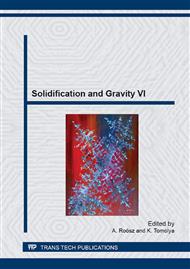[1]
N.C. McClure, A.U. Khan., D.D. McGrady, H.L. Womohel, Inoculation of grey cast iron, Transactions AFS 65 (1957) 340-349.
Google Scholar
[2]
I. Riposan, M. Chisamera, S. Stan, M. Barstow, Improving chill control in iron powder treated slightly hypereutectic grey cast iron, China Foundry 8 (2012) 228-234.
DOI: 10.1179/1743133611y.0000000010
Google Scholar
[3]
L. Elmquist, A. Dioszegi, Inoculation and its effect on primary solidification structure of hypoeutectic grey cast iron, International Journal of Cast Metal Research 23 (2010) 124-129.
DOI: 10.1179/136404609x12490478029317
Google Scholar
[4]
A. De Sy, Oxygen, oxides, superheating and graphite nucleation in cast iron, Modern Castings 52 (1967) 67-78.
Google Scholar
[5]
S. O. Olsen, T. Skaland, C. Hartung, Inoculation of grey and ductile iron a comparison of nucleation sites and some practical advises. Elkem ASA, Foundry Products Division, 14-th International Baltic Conference Materials Engineering'(2005).
Google Scholar
[6]
A. Dioszegi, K.Z. Liu, J.L. Svensson, Inoculation of primary austenite in grey cast iron, Cast Metals Research. (2007) 68-72.
DOI: 10.1179/174313307x216633
Google Scholar
[7]
E. Guzik, Processing of cast iron improvement, PAN, Katowice, (2001).
Google Scholar
[8]
ASM Handbook Volume 15, Casting, ASM International, (1992).
Google Scholar
[9]
V. Popovski, C. Misterek, L. Kaiser, Metallurgical comparison between operating conditions, inoculant types and fade effects in gray iron, Proceedings of the AFS Cast Iron Conference. Schaumburg, Illinois, 2005, p.57.
Google Scholar
[10]
R. E. Boeri, J.A. Sikora, Solidification macrostructure of spheroidal graphite cast iron, Int J Cast Met Res (2001) 307.
DOI: 10.1080/13640461.2001.11819412
Google Scholar
[11]
G. L. Rivera, R. E. Boeri, J.A. Sikora, Solidification of grey cast iron, Scriptamaterialia, 50 (2004) 331.
Google Scholar
[12]
G. L. Rivera, P. R. Calvillo, R. E. Boeri, Y. Houbaert., J.A. Sikora, Examination of the solidification macrostructure of spheroidal and flake graphite cast irons using DAAS and ESBD, Materials Characterization 59, 2008, p.1342.
DOI: 10.1016/j.matchar.2007.11.009
Google Scholar
[13]
R. Riviera, A. Diószegi, L. Elmquist, Solidification study of gray cast iron in a resistance furnace, Key Engineering Materials 457 (2011) 108-113.
DOI: 10.4028/www.scientific.net/kem.457.108
Google Scholar
[14]
B. Lux, W. Kurz, Solidification of metals, The Iron and Steel Institute, London, 110 (1967) 193.
Google Scholar


